
Organic reaction mechanisms - 1998
.pdf
13 Addition Reactions: Polar Addition |
435 |
|||||||||||||
Ph |
|
N |
|
|
Ph |
|
N |
Ph |
|
N |
||||
|
|
|
|
|
||||||||||
|
|
|
|
|
|
|
|
|
|
|
|
|
|
|
|
|
N |
|
N |
|
|
N |
|
|
N |
||||
|
|
|
|
|
|
|
|
N |
|
|
N |
|||
(86) |
|
|
(87) |
|
|
(88) |
|
|
||||||
4-aminopyridine, and a small amount of a dimerized product. β-Isomer (87) proved to be unreactive, but α-isomer (88) gave 2-(4-hydroxyphenylazo)pyridine, 4-amino- phenol, and 2-aminopyridine products. This reactivity pattern, resulting in an oxidized azo compound and two reduced amines, is similar to that found in the disproportionation of di-para-substituted hydrazinobenzenes observed in benzidine rearrangement studies. Consequently, it has been proposed that the corresponding [N -(4- hydroxyphenylhydrazino)] pyridines were formed as reaction intermediates in the present system, which was confirmed by showing that [N -4-(4-hydroxyphenylhydr- azino)]pyridine synthesized independently gave the same products as (86) under the same conditions. The kinetic study has demonstrated that the γ -isomer (86) reacted faster than the α-isomer (88) at all the acid concentrations investigated. Rate maxima were observed, at ca 72 wt% H2SO4 for (86) and ca 86 wt% H2SO4 for (88). To facilitate the kinetic analysis, values of pKBH2 2+ for the protonation of the substrates and the possible hydroxy products at the azo group were determined, using the excess acidity method; the first protonation occurs on the pyridine nitrogen. An excess acidity analysis of the observed pseudo-first-order rate constants as a function of acidity indicate an A2 mechanism, with the diprotonated substrate and either one HSO4− ion or one H2O molecule in the activated complex. The proposed mechanism thus involves nucleophilic attack of HSO4− or H2O at an aryl carbon of the diprotonated substrate in the slow step, resulting in an intermediate hydrazo species which gives the observed products in a subsequent fast step (cf. benzidine rearrangement).51
Nucleophilic Additions
Additions to Multiple Bonds Conjugated with C=O
High pressure vs thermal activation in the conjugate addition of amines has been examined as part of an effort to develop a new access to spirocyclamines. The reactions of methyl or ethyl 4-t-butylcyclohexylidene bromoacetates (89) with amines turned out to afford various products depending on the experimental conditions and the nature of the amine. When the starting ester (89) was treated with benzylamine in refluxing methanol, ester (90a) and the corresponding amide (90b) were isolated as the main products. By contrast, the same reaction, carried out at room temperature and under high pressure, led to a diastereoisomeric mixture of the spiroaziridine derivative (92) and (93) in good yield and high stereoselectivity.52
Microwave irradiation has been reported to accelerate the Michael addition of primary and cyclic secondary amines to esters of α,β-unsaturated α-unsubstituted carboxylic acids to produce β-amino acids.53
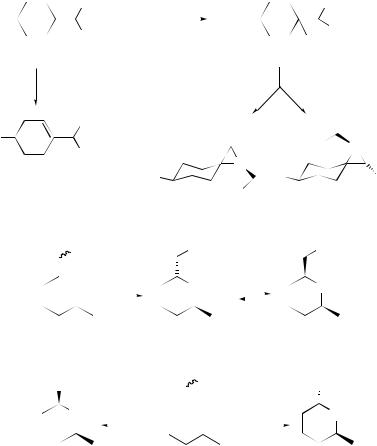
436 |
|
|
|
Organic Reaction Mechanisms 1998 |
|
|
CO2Me |
|
CO2Me |
But |
|
|
PhCH2NH2 |
|
|
|
|
But |
|
|
||||
|
|
|
||
|
|
Br |
|
Br |
|
|
|
HNCH2Ph |
|
(89) |
|
|
|
|
|
|
(91) |
||
|
COX |
|
|
|
|
|
|
CO2Me |
|
|||||||
But |
|
|
|
|
|
|
|
|||||||||
|
|
|
|
|
|
|
|
|
|
|
Ph |
N |
||||
|
NHCH2Ph |
|
|
|
|
|
|
|
|
|
||||||
|
|
|
|
|
|
N |
|
|||||||||
(90a) X = OMe |
|
But |
|
|
|
|
|
|
|
|
But |
CO2Me |
||||
(90b) X = NHCH2Ph |
|
|
|
|
|
|
|
Ph |
|
|||||||
|
|
|
|
|
|
(92) |
(93) |
|||||||||
|
CO2Me |
|
|
|
CO2Me |
|
|
|
|
|
CO2R |
|||||
|
OH |
|
|
|
O |
|
|
|
|
|
O |
|
||||
|
|
|
|
|
|
|
|
|
|
|||||||
|
|
|
|
|
|
|
|
|
|
|||||||
(94) |
|
|
|
|
(95) |
|
|
|
|
|
|
|
(96) R = Me |
|||
|
|
|
|
|
|
|
|
|
|
|
||||||
|
|
|
|
|
|
|
|
|
|
|
||||||
|
|
|
|
|
|
|
|
|
|
|
|
|
|
(97) R = H |
||
|
|
|
|
|
|
|
CO2Me |
|
||||||||
CO2Me |
|
|
|
|
|
|
|
|
|
|
|
CO2Me |
||||
|
|
|
|
|
|
|||||||||||
|
NH |
AcONH4 |
|
O |
|
AcONH4 |
NH |
|||||||||
|
|
|
||||||||||||||
|
|
|
|
|
|
|
|
|
|
|
|
|
|
|
|
|
|
|
|
|
NaBH3CN |
|
|
|
|
|
NaBH3CN |
|
|||||
|
|
|
|
|
|
|
|
|
||||||||
|
|
|
|
(E) |
|
|
|
|
|
|
(Z) |
|
||||
(99) |
|
|
|
|
(98) |
|
|
(100) |
|
|||||||
SCHEME 12
Intramolecular Michael addition of N - and O-centred nucleophiles to tethered acrylates has been elucidated and the role of double-bond geometry in controlling the diastereoselectivity of cyclizations assessed. Thus, the oxyanion derived from hydroxyacrylate (E)-(94) has been found to undergo readily an intramolecular Michael addition to give the trans-2,6-disubstituted tetrahydropyran (95) as the major product. By contrast, the oxyanion obtained from (Z)-(94) cyclizes to afford the cis-2,6-disubstituted tetrahydropyran (96). This chemistry has been extended to the enantioselective synthesis of (+)-(96), an intermediate in the synthesis of acid (+)-(97), a constituent of the glandular secretion from the civet cat (Viverra civetta). Similarly, the corresponding (E)- and (Z)-ketones (98) undergo a one-pot reductive amination, followed by a diastereoselective Michael-type cyclization to produce cis- and trans-piperidines (99) and (100), respectively. Chair-like transition-state structures have been proposed to account for the diastereoselectivities observed in these cyclizations.54
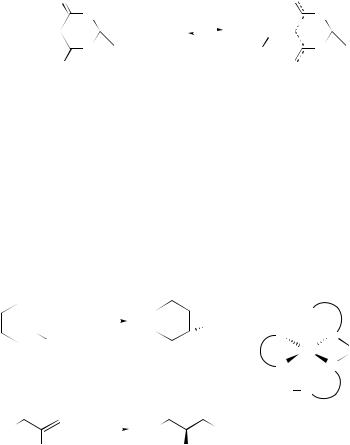
13 Addition Reactions: Polar Addition |
437 |
A kinetic study of the reaction of benzylidene Meldrum’s acid (101) with a series of thiolate and alkoxide ions RX− (X = S or O) in DMSO–water (1:1, v/v) at 20 ◦C has been reported. The reactions lead to adducts of the type (102), which can be viewed as a model for the intermediate of a nucleophilic vinylic substitution on substrates such as PhC(LG)=C(CO2)2CMe2(LG = leaving group). The kinetic measurements allowed the determination of rate and equilibrium constants for these processes with RS− = n-BuS−, HOCH2CH2S−, MeO2CCH2CH2S−, and MeO2CCH2S− and RO− = HO−, MeO− (only rate constant of breakdown of adduct), HCCCH2O−, and CF3CH2O−. The results show that there are major differences between the alkoxide and thiolate ions with respect to their thermodynamic and kinetic affinities to (101). They arise mainly from differences in the polarizability and solvation between the sulfur and the oxygen bases. Similar differences in the reactions of thiolate ions with α-nitrostilbenes have also been discussed.55
|
O |
|
|
|
|
Ph |
O |
||
Ph |
|
O |
|
|
|
|
O |
||
|
|
|
|
|
|
|
|||
|
|
+ RX− |
|
|
|
H |
|
C − |
|
|
|
||||||||
|
|
|
|
|
|||||
|
|
|
|||||||
|
|
|
|
|
|
||||
|
|
O |
|
|
|
RX |
O |
||
|
O |
|
|
|
O |
||||
|
|
|
|
|
|
|
|||
|
(101) |
|
|
|
|
|
|
(102) |
|
An efficient asymmetric Michael addition of thiols to cycloalkenones (103) (56–90% ee) and an effective asymmetric protonation in Michael additions of thiols to non-cyclic enones (104) (75–90% ee), catalysed by LaNa3• tris(binaphthoxide) (105) and SmNa3• tris(binaphthoxide) (106) complexes, respectively, has been reported.56
Both diastereoisomers of β-homothreonine derivatives (109) and their 2-deuteriated analogues have been synthesized by 1,4-addition of homochiral lithium amides (107) as nitrogen nucleophiles to γ -alkoxyenoates (108) (Scheme 13). The product distribution of the 1,4-addition depends strongly on the nature of the substrate (110) vs
O |
|
|
|
|
O |
|
|
|
|
|
|
|
|||||||
|
|
|
|
|
|
R2SH |
|
|
|
|
SR2 |
Na |
|
O |
* |
||||
|
|
|
|
|
|
|
|
|
|
|
|||||||||
|
|
|
|
|
|
|
|
|
|
||||||||||
|
|
|
|
|
|
|
|
|
|
|
|
|
|
|
|
|
|
||
|
|
|
|
|
|
La L |
|
|
|
|
|
|
|
|
|
O |
|||
( )n R1 |
( )n |
O |
|
|
|
||||||||||||||
|
|
|
R1 |
|
|
|
|||||||||||||
|
|
|
* |
|
|
M |
Na |
||||||||||||
(103) |
|
|
|
|
|
|
|
|
O |
|
|
|
O |
||||||
|
|
|
|
|
|
|
|
|
|
|
|
|
|
|
|
|
|
|
|
|
O |
|
|
|
O |
|
Na |
|
O |
* |
|||||||||
|
|
|
|
|
(105) M = La |
||||||||||||||
|
|
|
|
|
|
R2SH |
|
|
|
|
|
||||||||
|
|
|
|
|
|
|
|
|
|
|
|||||||||
R3 |
|
|
|
R3 |
SR2 |
(106) M = Sm |
|||||||||||||
La/Sm L |
|||||||||||||||||||
|
|
|
|
R4 |
|
|
|
R4 |
|
|
|
|
|
|
|
||||
|
|
|
|
|
|
|
|
|
|
|
|
|
|
|
|
|
|||
(104) |
|
|
|
|
|
|
|
|
|
|
|
|
|
|
|||||
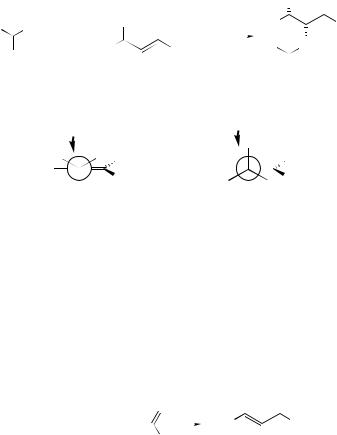
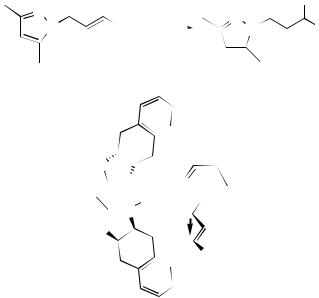
13 Addition Reactions: Polar Addition |
|
|
|
|
|
439 |
|||||
O |
|
|
|
|
O |
NHOBn |
|||||
N |
|
|
|
H2N−OBn |
N |
|
|
|
|
||
|
|
|
|
||||||||
N |
R |
|
|
|
|||||||
|
|
|
N |
|
R |
||||||
MgBr2/L |
|
|
|||||||||
|
|
|
|
|
|
|
|
|
|
||
(115) |
|
|
|
(116) |
|
|
|||||
O
 N
N Mg .....N.
Mg .....N.  N
N 
 N
N  O
O
O
R
(117)
P−H activation by the unsaturated fragments directly bonded to the phosphorus atom.61
Kinetics of the formation of indolizines (119) via thermal cyclization of 3-acetoxy- 2-methylene-3-(2-pyridyl)propanoic esters (118) and analogues have been investigated using 1H NMR spectroscopy; the data obtained were as follows: H= = 97 ± 6 kJ mol−1, S= = 413 ± 11 J K−1 mol−1 and ρ = 3.75. A mechanism involving the 5-endo-Trig ring closure was proposed to account for the formation of (119).62 Since this would be a typical disfavoured process according to the Baldwin rules, the present reviewer feels that an alternative mechanism would be more a likely, namely one involving Claisen rearrangement, generating (120) as the substrate for an SN2-type
5-exo-Tet process, or a conrotatory cyclization of cation (121) arising by departure of AcO−.
A detailed elucidation of both solid-state and solution structures of a series lithiated α-aminonitriles [RC(NR2)CN]−Li+ has been employed to formulate the transitionstate structures that account for the diastereofacial selectivity observed in their 1,4-additions to Michael acceptors.63
In the presence of ZnCl2, Michael addition of anthrone (122) to α,β-unsaturated ketones has been reported to proceed smoothly, producing mono-adducts (123), whereas bis-adducts (124) are formed in basic solution.64
Sodium benzoate has been identified as a mild and efficient catalyst for the tandem Michael–aldol self-condensation of γ ,δ-unsaturated-β-keto esters, affording conjugated vinylcyclohexenonedicarboxylates, some of which exhibit biological activity against ectoparasites in cattle.65

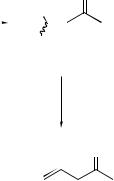
13 Addition Reactions: Polar Addition |
441 |
A mechanistic study of the transformation of dec-3-yn-2-one (125) into (Z)-4- iododec-4-en-2-one (127) on treatment with Me3SiCl and NaI in wet MeCN has revealed the following (Scheme 14): (1) Me3SiCl undergoes an exchange reaction with NaI and the resulting Me3SiI reacts with 0.5 equiv. of H2O to produce HI and (Me3Si)2O; (2) the liberated HI is non-stereoselectively added in a Michael fashion across the conjugated C≡C bond to generate vinyl iodide (126) as a mixture of E- and Z-isomers; (3) the latter intermediate is then deconjugated by the remaining Me3SiI to give the final product (127) stereoselectively as the Z-isomer.67
O
|
|
|
|
|
|
|
|
C6H13 |
|||
C6H13 |
|
C |
|
C |
|
COMe |
Me3SiCl, NaI |
||||
|
|
|
|
|
|
|
|
||||
|
|
|
|
|
|
|
|
||||
|
|
|
MeCN, H2O |
||||||||
|
|
||||||||||
|
|
|
|
|
|
|
|
I |
|||
(125) |
|
|
(126) |
||||||||
Me3SiI
cat.
I O
C5H11 
(127)
NaI
Me3SiCl  Me3SiI
Me3SiI
−NaCl
2Me3SiI + H2O  HI + (Me3Si)2O
HI + (Me3Si)2O
SCHEME 14
Asymmetric Michael reactions of 1,4-naphthoquinones (128) bearing a chiral auxiliary with 2-trimethylsilyloxyfuran (129) using various Lewis acids afforded the corresponding furofuran adducts (130). Moderate levels of diastereoisomeric excess ( 60% de) were obtained using (R)-pantolactone, (S)-N -methyl-2-hydroxysuccinimide and (R)-(+)-4-benzyl-2-oxazolidinone as chiral auxiliaries. Low asymmetric induction was achieved using a camphorsultam auxiliary. Evidence that the addition of (129) occurs via a Michael reaction rather than a Diels–Alder cycloaddition has been provided.68
The diastereoselectivity in the asymmetric Michael reaction using chiral enamines, derived from β-dicarbonyls and chiral 1-alkylphenylamines, e.g. (131), under neutral conditions has been investigated with the aid of AM1 calculations. The energy differences between the two competing transition states involving enamino ketone and methyl acrylate (132) are in good agreement with the diastereoselectivities observed for the corresponding chiral imines, derived from 1-phenylethylamine (95% de). The calculated transition structures indicate that the π -facial discrimination originates in steric factors.69

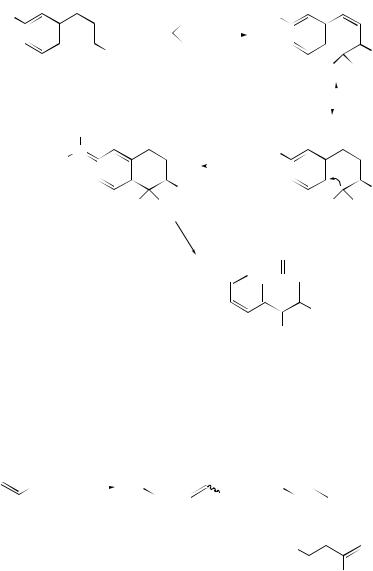
13 Addition Reactions: Polar Addition |
|
|
|
|
443 |
||||||||||||
|
O |
|
|
|
|
|
|
|
|
O− |
|||||||
O2N |
|
|
|
|
|
|
SPh |
|
O2N |
|
|
|
|||||
|
|
|
|
|
|||||||||||||
|
|
|
|
|
|
+ |
|
|
− |
|
|
|
|
|
|
|
|
|
|
|
|
|
|
|
|
|
|
|
|
|
|||||
|
|
|
|
|
|
|
|
CN |
|
|
|
|
|
|
|
||
|
|
|
|
|
|
Ph |
|
|
|
|
|
|
|
|
Ph |
||
|
|
|
|
|
|
|
|
|
|
|
|
|
|
|
|
||
|
|
|
|
|
|
|
|
|
|
|
|
PhS |
|
|
CN |
||
(133) |
|
|
|
|
|
|
|
|
|
|
|
|
|
|
|||
|
|
|
|
|
|
|
|
|
|
|
|
|
|
||||
|
|
O− |
O |
|
|
|
|
O |
|||||||||
|
|
|
|
|
|
||||||||||||
|
|
|
|
|
|
||||||||||||
|
|
N+ |
|
|
|
|
|
O2N |
|
|
|
||||||
|
|
|
|
|
|
|
|
|
|||||||||
−O |
|
|
|
|
|
|
|
|
|
|
|
||||||
|
|
|
|
|
|
|
|
|
|
|
|||||||
|
|
|
|
|
|
|
|
|
Ph |
|
|
|
|
|
|
Ph |
|
|
|
|
|
|
|
|
|
|
|
|
|
|
|
|
|||
|
|
|
|
|
|
|
|
|
|
|
|
|
|||||
|
|
|
|
|
|
PhS |
|
|
CN |
|
PhS |
|
|
CN |
|||
(134) |
|
|
|
|
|
|
|
|
|||||||||
O
O2N


Ph
CN
(135)
SCHEME 15
which is a potential source of hexamethylenediamine, were reported in detail and the factors which govern rate and selectivity to form the linear products (136) and (137) rather than the branched isomer (138) were elaborated.72
CN |
Ar2POPri |
|
NC |
|
|
NC |
+ |
||
|
||||
|
|
CN |
|
CN |
|
(136) |
|
(137) |
|
|
|
|
|
+ |
|
|
|
|
NC |
|
|
|
|
CN |
|
|
|
|
(138) |
Additions to Multiple Bonds Activated by Other Electron-withdrawing Groups
Diastereoselective tandem conjugate addition of both oxygenand nitrogen-centred nucleophiles (potassium phthalimide, TsNHK, MeONa, and Me3SiOK) to the novel (1S)-10-camphorsulfonic acid-derived nitroalkenes (139; R = Me, Pri , and
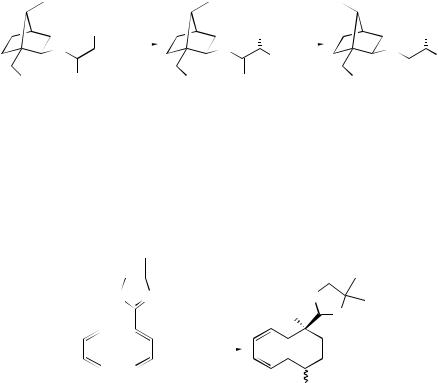
444 |
Organic Reaction Mechanisms 1998 |
p-C6H4CO2But ), followed by ozonolysis, gave the α-hydroxy and α-amino thiol acid derivatives (140). In all cases, the (R)-diastereoisomer was formed as the major component albeit with only modest levels of selectivity (33–71% de).73
|
|
R |
Nu−M+ |
|
|
|
Nu |
O3 |
|
|
|
|
|
Nu |
||
|
S |
|
S |
|
|
|
S |
|
|
|
|
|
||||
|
|
|
|
|
|
R |
|
|
|
|
|
|
R |
|||
|
|
|
|
|
|
|
|
|
|
|
|
|
|
|
||
|
|
|
|
|
|
|
|
|
|
|
|
|
||||
SO NPri |
|
|
SO NPri |
|
NO− |
|
SO NPri |
|
|
|
|
|
||||
NO2 |
|
O |
||||||||||||||
2 |
2 |
|
2 |
2 |
2 |
2 |
2 |
|
|
|
|
|
||||
(139) |
|
|
|
|
|
|
|
|
|
(140) |
|
|
|
|
|
|
SCHEME 16
The addition of substituted anilines to trans-β-nitrostyrene has been reported to involve the formation of a zwitterionic intermediate in the rate-determining step, followed by a rapid intramolecular proton transfer.74
The 1,6-addition reaction of lithium amides to the naphthalene ring system (141) followed by the electrophilic alkylation has been reported (Scheme 17).75
O N |
O |
||||||
|
|
|
Me |
|
N |
||
|
|
1. BnNHLi |
|
|
|||
|
|
2. MeI |
|
|
|
|
|
|
|
|
|
||||
|
|
|
|
|
|
|
|
|
|
|
|
|
|
|
|
HNBn
(141)
SCHEME 17
The benzo[b]thiophene sulfoxides, such as (142), generated from the parent benzothiophene on the H2O2 –TFA-mediated oxidation, undergoes Michael-type nucleophilic addition of oxygen and sulfur nucleophiles in acidic media to produce 3-substituted benzo[b]thiophenes (143). This method provides an easy two-step functionalization of 2-acylbenzo[b]thiophene derivatives.76
A ring–chain transformation with slow interconversion (compared with the NMR time-scale) has been reported in the solution of (144) and related derivatives. On the other hand, no tautomerism was observed when the benzene ring was replaced by a thiophene ring or an aliphatic double bond.77
In the Michael addition reaction of (S)-phenylethylamine and L-alanine isopropyl ester to ω-nitrostyrene, the diastereoisomer formation has been found to be thermodynamically controlled.78

 +
+ N
N

 O
O